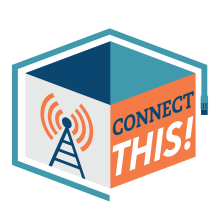
Fast, affordable Internet access for all.


Join us Friday, December 1st at 2pm ET for the latest episode of the Connect This! Show. Co-hosts Christopher Mitchell (ILSR) and Travis Carter (USI Fiber) will be joined by regular guests Doug Dawson (CCG Consulting) and Kim McKinley (UTOPIA Fiber) and special guest Mike Dano (Editorial Director, 5G & Mobile Strategies, Light Reading) to tackle the future of LTE networks - how did we get here, and where are we going? They'll talk about what happened to the 5G hype train, rural mobile wireless, market dynamics, and more. Go back and watch The Only History of LTE You'll Ever Need to catch up on part one of the discussion.
First, the crew tackles the FCC's digital discrimination proceeding in the context of ILSR Researcher Emma Gautier's recent piece on the subject. Then, they pause for a brief moment on what looks like a new dark money, anti-municipal broadband campaign aimed at UTOPIA Fiber in Utah. Finally, Christopher, Kim, Doug, and Travis are joined by Mike Dano to jump into the main subject of today's show: where we're at now, and where we expect to go, with mobile wireless networks.
Email us at broadband@communitynets.org with feedback and ideas for the show.
Subscribe to the show using this feed or find it on the Connect This! page, and watch on LinkedIn, on YouTube Live, on Facebook live, or below.

Join us Wednesday, October 11th at 3pm ET for the latest episode of the Connect This! Show. Co-hosts Christopher Mitchell (ILSR) and Travis Carter (USI Fiber) will be joined by regular guests Doug Dawson (CCG Consulting) and Kim McKinley (UTOPIA Fiber), with special guest Matt Larsen (Vistabeam) to talk about innovation in fixed wireless deployments, and a grab bag of other topics.
Email us at broadband@communitynets.org with feedback and ideas for the show.
Subscribe to the show using this feed or find it on the Connect This! page, and watch on LinkedIn, on YouTube Live, on Facebook live, or below.

This week on the podcast, ILSR Senior Reporter and Editor Sean Gonsalves joins the show for another installment of Crazy Talk. Today's topic is fiber, with the two breaking down a recent op-ed in The Hill by Technology Policy Institute President Scott Wallsten. Christopher and Sean inject a much-needed reality check, as well as some nuance, to Wallsten's performative anxiety that public broadband subsidies supporting fiber optic deployments will leave rural America behind.
They talk about the broken history of regulation and accountability that "technology neutral" arguments like Wallsten's harmfully perpetuates, when fixed wireless networks do make sense to support, and the often-underappreciated work being done by local governments across the country to maintain fiber infrastructure that they've been using to serve their communities well for decades.
This show is 35 minutes long and can be played on this page or via Apple Podcasts or the tool of your choice using this feed.
Transcript below.
We want your feedback and suggestions for the show-please e-mail us or leave a comment below.
Listen to other episodes here or view all episodes in our index. See other podcasts from the Institute for Local Self-Reliance here.
Thanks to Arne Huseby for the music. The song is Warm Duck Shuffle and is licensed under a Creative Commons Attribution (3.0) license.
Join us live on Friday, September 16, at 1pm ET for the latest episode of the Connect This! Show. Co-hosts Christopher Mitchell (ILSR) and Travis Carter (USI Fiber) will be joined by Deborah Simpier (Co-founder at Althea Networks, Sommelier Finance, and Gravity Bridge) and Sascha Meinrath (Palmer Chair in Telecommunications at Penn State University, Founder of X-Lab). They'll discuss the advantages of different wireless deployments (LTE vs. licensed spectrum vs. unlicensed spectrum) as compared to fiber, the present and future of distributed, member-owned networks, and more.
Email us at broadband@muninetworks.org with feedback and ideas for the show.
Subscribe to the show using this feed or find it on the Connect This! page, watch on YouTube Live, on Facebook live, or below.
Join us live on Friday, September 16, at 1pm ET for the latest episode of the Connect This! Show. Co-hosts Christopher Mitchell (ILSR) and Travis Carter (USI Fiber) will be joined by Deborah Simpier (Co-founder at Althea Networks, Sommelier Finance, and Gravity Bridge) and Sascha Meinrath (Palmer Chair in Telecommunications at Penn State University, Founder of X-Lab). They'll discuss the advantages of different wireless deployments (LTE vs. licensed spectrum vs. unlicensed spectrum) as compared to fiber, the present and future of distributed, member-owned networks, and more.
Email us at broadband@muninetworks.org with feedback and ideas for the show.
Subscribe to the show using this feed or find it on the Connect This! page, watch on YouTube Live, on Facebook live, or below.
On Episode 19 of the Connect This! Show, co-hosts Christopher and (a partly there) Travis Carter (USI Fiber) are joined by Keith Hanson (Shreveport, Louisiana Chief Technology Officer) and Angelina Panettieri (National League of Cities) to talk about how some cities place themselves at the vanguard of innovation by undertaking projects designed to improve local conditions using existing infrastructure and know-how. Keith shares Shreveport's efforts to map the digital divide by connecting low-power computing devices to GPS sensors and cell phone batteries on garbage trucks to map broadband access across the city. He also talks about other edge computing initiatives, like video for public safety.
The group also discusses the newly released Treasury rules on the $10 billion in infrastructure funding coming down the pipeline, and how cities can position themselves to take advantage.
Subscribe to the show using this feed, or visit ConnectThisShow.com
Email us broadband@muninetworks.org with feedback, ideas for the show, or your pictures of weird wireless infrastructure to stump Travis.
Watch here, or below.
On Episode 19 of the Connect This! Show, co-hosts Christopher and Travis Carter (USI Fiber) are joined by Keith Hanson (Shreveport, Louisiana Chief Technology Officer) and Angelina Panettieri (National League of Cities) to talk about how some cities place themselves at the vanguard of innovation by undertaking projects designed to improve local conditions using existing infrastructure and know-how. For instance, in this episode of the show, Keith will share Shreveport's efforts to bridge the digital divide: an initiative driven in part by connecting low-power computing devices to GPS sensors and cell phone batteries on garbage trucks to map broadband access across the city.
The group will also discuss the newly released Treasury rules on the $10 billion in infrastructure funding coming down the pipeline.
Join us for the live show Thursday, September 23rd, at 5pm ET.
Subscribe to the show using this feed, or visit ConnectThisShow.com
Email us broadband@muninetworks.org with feedback, ideas for the show, or your pictures of weird wireless infrastructure to stump Travis.
Watch here, or below.
This piece was authored by Ahmad Hathout, Assistant Editor for Broadband Breakfast. Originally appearing at broadbandbreakfast.com on August 25, 2021, the piece is republished with permission.
The House’s decision to delay passage of the $65 billion spending on broadband included in the infrastructure bill means that final action will wait until Congress returns from its summer break and comes back again for scheduled votes beginning September 20.
Fiber and wireless providers remain optimistic about infrastructure investments in future networks, even as a top lawmaker on Wednesday voiced lingering concerns about spectrum-related provisions in the Senate-passed bill.
On Tuesday, the House passed a budget resolution on a separate $3.5 trillion spending package that is only supported by Democrats. House Speaker Nancy Pelosi put on hold – until September 27 – a commitment to vote on the $1.2 trillion infrastructure package, which enjoys bipartisan support.
The particulars of the broadband segment of the infrastructure measure that passed the Senate on August 10 have been reported, but not yet fully digested. The bill include grants for service providers that provide broadband at 100 Megabits per second (Mbps) download and 20 Mbps upload.
Upload Speeds a Center of Discussion
That in itself would be a significant bump up from the current federal definition of “broadband” as being 25 Mbps down and 3 Mbps up.
But some broadband enthusiasts wanted Congress to push for the symmetrical speeds that some Democratic lawmakers have asked for. Symmetrical speeds, in which the up speed is equal to the down speed, are generally seen to favor fiber deployment.
Still, the final measure that passed the Senate decreed that anything under 100 Mbps down would be categorized as “underserved.”
Decatur, Illinois (pop. 71,000) is moving forward with an Institutional Network (I-Net) expansion that will connect 11 school districts and 3 firehouses to its growing fiber-optic backbone, connecting potential commercial and industry customers along the way.
The city of Decatur has been expanding its fiber network since 2014, when it decided to deploy a backbone network connecting several of its facilities. This most recent expansion will extend the access to Franklin and Parsons schools, Stephen Decatur Middle School, Eisenhower and MacArthur high schools, American Dreamer STEM Academy, Dennis Lab School, Hope Academy, Johns Hill Magnet School and William Harris Learning Academy.
The expansion is the result of a 5-0 city council vote in April approving a $915,000 contract with Bodine Electric to purchase and hang 144 strand fiber-optic cable.
A portion of the funding for the contract will come from a $800,000 grant from the Connect Illinois grant program, an initiative aimed at expanding broadband access. The program launched in 2019 with $420-million investment in broadband infrastructure. The first round of grants totaled $50 million with a combined $9.25 million going to monopoly ISPs CenturyLink, MediaCom, Spectrum, and Comcast and the rest going to local ISPs and city and county governments.
The remaining $115,000 allocated in the contract will come from the state’s portion of the American Rescue Plan fund.
While the city will fund the expansion of the backbone to pass by the schools and connect the firehouses, Decatur Public Schools (DPS) will also contribute $600,000 to connect the schools to the street fiber. The contribution is also from the Connect Illinois Grant Program.
When the state grants came through, the city and DPS saw an opportunity to collaborate.
Washtenaw County (pop. 367,600), home of B-24 bomber, a once booming automotive industry and the University of Michigan, is making strides toward bringing the region back into an economic powerhouse, running 20 miles of fiber from downtown Ann Arbor through Ypsilanti Township, connecting the business and commercial corridors of four different townships ultimately ending at the American Center for Mobility.
Ann Arbor SPARK, a non-profit economic development organization, received $2.4 million in federal funding from the CARES Act in July to start the Ann Arbor-Ypsilanti Corridor Fiber Optic Backbone project. Ann Arbor Spark contributed $200,000 to the $600,000 local match requirement needed to obtain the funds, while Washtenaw County contributed $112,000, the City of Ann Arbor contributed $138,000, and Ann Arbor/Ypsilanti Local Development Finance Authority contributed $150,000.
Shaking off the Rust
Ypsilanti, Michigan (pop. 20,800) led the country in cutting edge automotive manufacturing for decades. Just 5 miles east of Ypsilanti, lay the Willow Run manufacturing complex and airport where Henry Ford produced B-24 heavy bombers for World War II, spurring a flood of workers in the region and ultimately leading to a housing shortage. The influx overwhelmed the market, forcing the Federal Public Housing Administration to step in and build dormitories for the workers. When the war ended, automotive manufacturers shuffled in and out of the complex, continuing to create jobs.
